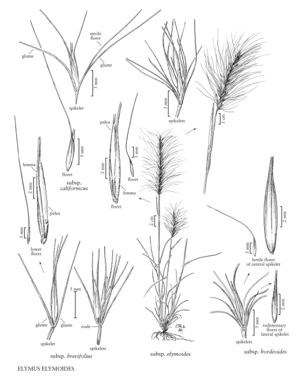familyPoaceae
subfamilyPoaceae subfam. Pooideae
genusElymus
speciesElymus elymoides
subspeciesElymus elymoides subsp. elymoides
Difference between revisions of "Elymus elymoides subsp. elymoides"
Common names: Common squirreltail
Synonyms: Elymus sitanion
Treatment appears in FNA Volume 24. Treatment on page 319.
FNA>Volume Importer |
imported>Volume Importer |
||
| (4 intermediate revisions by 2 users not shown) | |||
| Line 1: | Line 1: | ||
{{Treatment/ID | {{Treatment/ID | ||
|accepted_name=Elymus elymoides subsp. elymoides | |accepted_name=Elymus elymoides subsp. elymoides | ||
| − | |accepted_authority= | + | |accepted_authority= |
|publications= | |publications= | ||
|common_names=Common squirreltail | |common_names=Common squirreltail | ||
| Line 7: | Line 7: | ||
|synonyms={{Treatment/ID/Synonym | |synonyms={{Treatment/ID/Synonym | ||
|name=Elymus sitanion | |name=Elymus sitanion | ||
| − | |authority= | + | |authority= |
| + | |rank=species | ||
}} | }} | ||
|hierarchy=Poaceae;Poaceae subfam. Pooideae;Poaceae tribe Triticeae;Elymus;Elymus elymoides;Elymus elymoides subsp. elymoides | |hierarchy=Poaceae;Poaceae subfam. Pooideae;Poaceae tribe Triticeae;Elymus;Elymus elymoides;Elymus elymoides subsp. elymoides | ||
| Line 19: | Line 20: | ||
-->{{Treatment/Body | -->{{Treatment/Body | ||
| − | |discussion=<p>Elymus elymoides subsp. elymoides grows in desert and shrub-steppe areas of western North America, extending to the western edge of the Great Plains and, as an adventive, occasionally further east. It is frequently associated with disturbed sites.</p> | + | |discussion=<p><i>Elymus elymoides </i>subsp.<i> elymoides</i> grows in desert and shrub-steppe areas of western North America, extending to the western edge of the Great Plains and, as an adventive, occasionally further east. It is frequently associated with disturbed sites.</p> |
|tables= | |tables= | ||
|references= | |references= | ||
| Line 28: | Line 29: | ||
-->{{#Taxon: | -->{{#Taxon: | ||
name=Elymus elymoides subsp. elymoides | name=Elymus elymoides subsp. elymoides | ||
| − | + | |authority= | |
| − | |authority= | ||
|rank=subspecies | |rank=subspecies | ||
|parent rank=species | |parent rank=species | ||
| Line 35: | Line 35: | ||
|basionyms= | |basionyms= | ||
|family=Poaceae | |family=Poaceae | ||
| − | |illustrator=Cindy Roché | + | |illustrator=Cindy Roché;Annaliese Miller |
| + | |illustration copyright=Utah State University | ||
|reference=None | |reference=None | ||
|publication title= | |publication title= | ||
|publication year= | |publication year= | ||
|special status= | |special status= | ||
| − | |source xml=https:// | + | |source xml=https://bitbucket.org/aafc-mbb/fna-data-curation/src/200273ad09963decb8fc72550212de541d86569d/coarse_grained_fna_xml/V24/V24_449.xml |
|subfamily=Poaceae subfam. Pooideae | |subfamily=Poaceae subfam. Pooideae | ||
|tribe=Poaceae tribe Triticeae | |tribe=Poaceae tribe Triticeae | ||
Latest revision as of 17:23, 11 May 2021
Culms 15-45 cm, erect to decumbent. Blades usually puberulent abaxially, sometimes glabrous. Spikes 4-15 cm, exserted or partly included, usually with 2 spikelets per node. Spikelets with (1)2-3(4) fertile florets, lowest 1-2 florets sterile and glumelike. Glume awns 35-85 mm, often split into 2, sometimes 3, unequal divisions; lemma awns 25-75 mm, usually exceeded by those of the glumes; paleas with the veins extended as bristles.
Discussion
Elymus elymoides subsp. elymoides grows in desert and shrub-steppe areas of western North America, extending to the western edge of the Great Plains and, as an adventive, occasionally further east. It is frequently associated with disturbed sites.
Selected References
None.
Lower Taxa
None.
